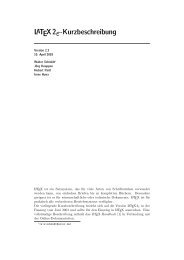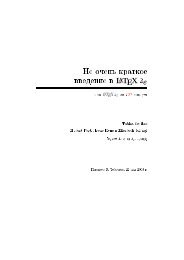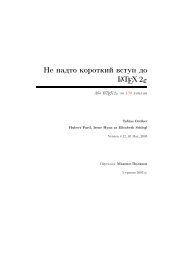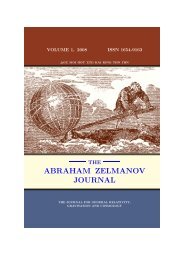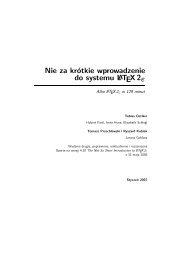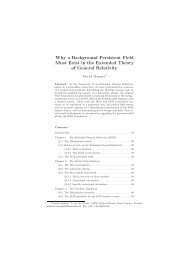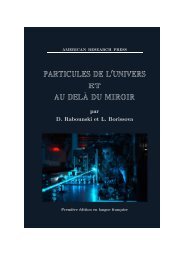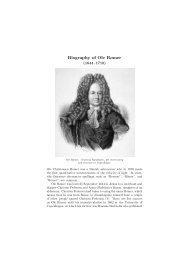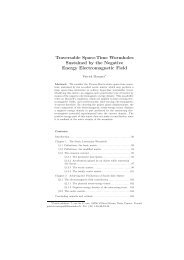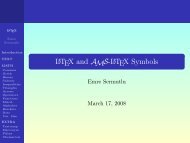A Short List of the Symbols Available in TX Fonts
A Short List of the Symbols Available in TX Fonts
A Short List of the Symbols Available in TX Fonts
- No tags were found...
Create successful ePaper yourself
Turn your PDF publications into a flip-book with our unique Google optimized e-Paper software.
STABILITY OF CERTAIN OSCILLATORY INTEGRALS 3<strong>in</strong> particular, we can embed N as a subgroup <strong>of</strong> ˜G via n ↦→ (n, 1). Consider <strong>the</strong> spaceΩ gen (N\ ˜G, ψ N ) <strong>of</strong> smooth genu<strong>in</strong>e functions W on ˜G such that W ((n, 1)g) = ψ N (n)W (g)for all n ∈ N, g ∈ ˜G. Theorems 1 and 2 are also valid for Ω gen (N\ ˜G, ψ N ). In a forthcom<strong>in</strong>gpaper we will use <strong>the</strong>se results to analyze <strong>the</strong> Whittaker coefficients <strong>of</strong> cusp forms on <strong>the</strong>metaplectic group [LM].Acknowledgement. We thank <strong>the</strong> referee for useful suggestions.2. Notation and prelim<strong>in</strong>ariesWe first fix some more notation. Throughout F will be a p-adic field with r<strong>in</strong>g <strong>of</strong> <strong>in</strong>tegersO, normalized absolute value ∣ ∣·∣∣and valuation v. Let G be a semisimple split group overF <strong>of</strong> rank r. (Theorems 1 and 2 easily reduce to <strong>the</strong> semisimple case.) Let B be a Borelsubgroup <strong>of</strong> G, A a maximal F -split torus conta<strong>in</strong>ed <strong>in</strong> B and N <strong>the</strong> unipotent radical <strong>of</strong>B so that B = AN. Let B = AN be <strong>the</strong> opposite Borel subgroup with respect to A. LetK be a hyperspecial maximal compact subgroup <strong>of</strong> G <strong>in</strong> good position with respect to B.We have Iwasawa decomposition G = ANK. Let X ∗ (A) (resp. X ∗ (A)) be <strong>the</strong> lattice <strong>of</strong>rational characters (resp. co-characters) <strong>of</strong> A.2.1. Roots and weights. Let Φ ⊆ X ∗ (A) be <strong>the</strong> set <strong>of</strong> roots <strong>of</strong> A <strong>in</strong> Lie(G), Φ + <strong>the</strong>subset <strong>of</strong> positive roots and ∆ 0 <strong>the</strong> subset <strong>of</strong> simple roots with respect to B. Similarly,let ∆ ∨ 0 ⊆ Φ ∨ + ⊆ Φ ∨ ⊆ X ∗ (A) be <strong>the</strong> sets <strong>of</strong> (simple, or positive) co-roots. We denote byα ↔ α ∨ <strong>the</strong> canonical bijection between Φ and Φ ∨ (resp., Φ + ↔ Φ ∨ +, ∆ 0 ↔ ∆ ∨ 0 ).For any α ∈ Φ let N α be <strong>the</strong> one-parameter subgroup correspond<strong>in</strong>g to α and choose aparametrization n α : G a → N α def<strong>in</strong>ed over F such that n α (O) = N α ∩ K. For any α ∈ ∆ 0we write N α for <strong>the</strong> unipotent radical <strong>of</strong> <strong>the</strong> (semisimple) rank one parabolic subgroupB ∪ Bs α B. Thus, N = N α ⋉ N α . We also have(3) N ∩ K = (N α ∩ K) ⋉ (N α ∩ K).Let a ∗ 0 = X ∗ (A) ⊗ R and a 0 = X ∗ (A) ⊗ R. These are r-dimensional R-vector spaces and∆ 0 (resp., ∆ ∨ 0 ) is a basis for a ∗ 0 (resp., a 0 ). The canonical pair<strong>in</strong>g 〈·, ·〉 : X ∗ (A)×X ∗ (A) → Zextends to a par<strong>in</strong>g a ∗ 0 × a 0 → R. Any λ = ∑ ∣ α∈∆ 0r α α ∈ a ∗ 0 def<strong>in</strong>es a positive character∣ λ : A → R+ given by∣ ∏ ∣ ∣∣ λ∣(t) = ∣α(t) r α.α∈∆ 0By Iwasawa decomposition we extend ∣ ∣ λ to a left-N and right-K <strong>in</strong>variant function on G.For any compact subset C ⊆ G <strong>the</strong>re exists a constant κ C > 0 (depend<strong>in</strong>g also on λ) suchthat∣ ∣ ∣ ∣ ∣(4) κ −1 ∣ λ∣(g) ≤ ∣λ∣(gh) ≤ κC∣λ∣(g)Cfor all g ∈ G, h ∈ C.Let H : A → a 0 be <strong>the</strong> homomorphism def<strong>in</strong>ed by q −〈χ,H(t)〉 = ∣ ∣ χ(t)∣ ∣ for all t ∈ A,χ ∈ X ∗ (A). Thus, H(χ ∨ (r)) = v(r)χ ∨ for any χ ∨ ∈ X ∗ (A).



